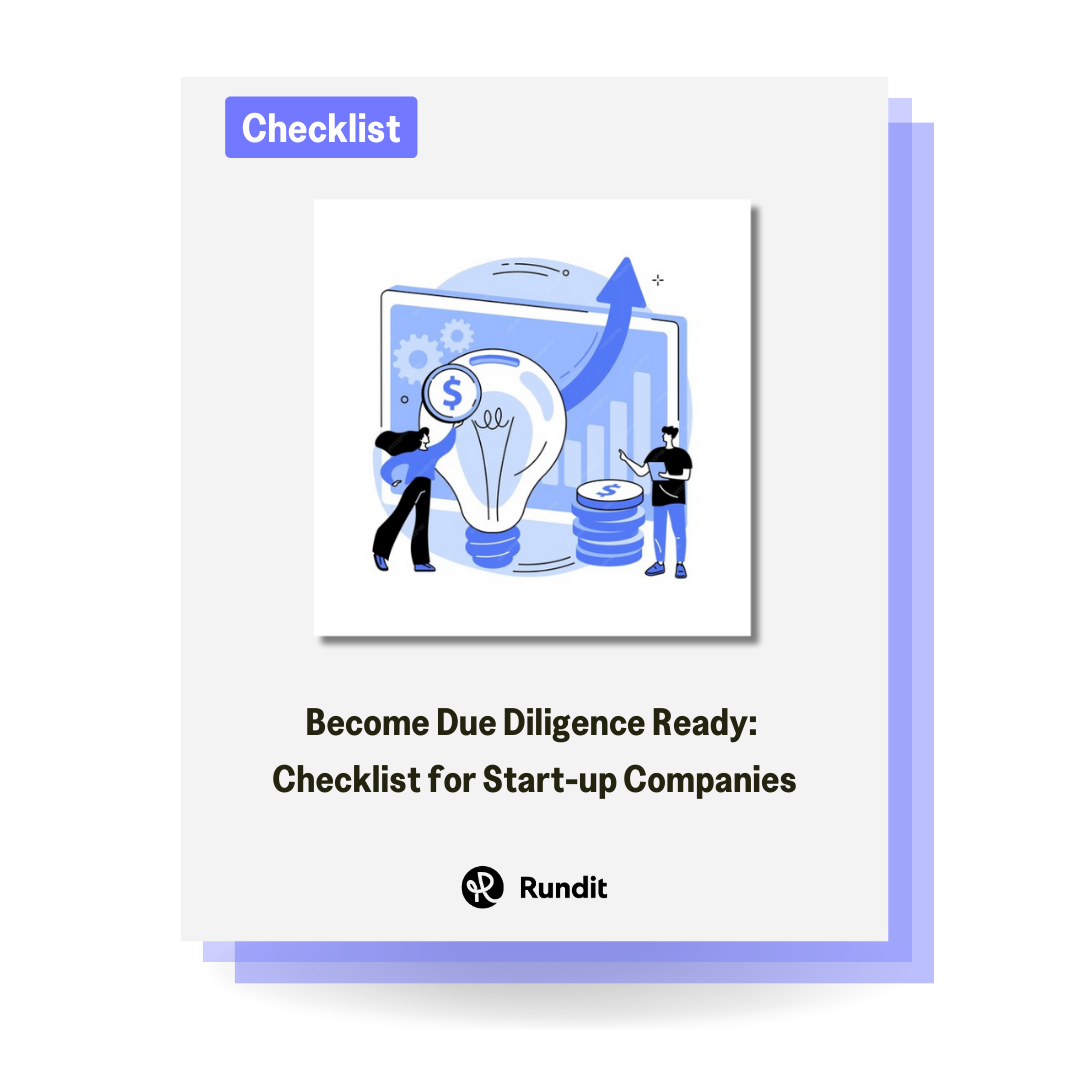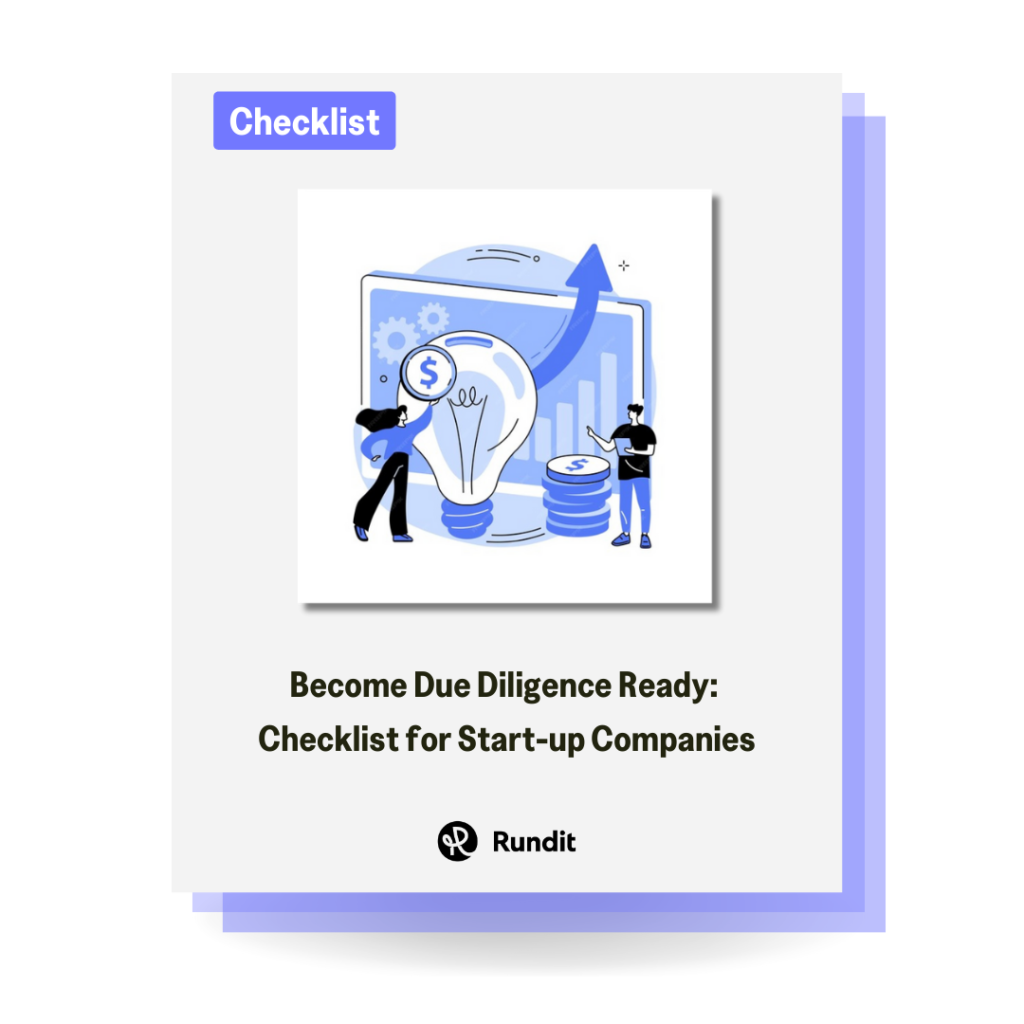
Table of Contents
For start-ups aiming to attract investors and secure growth opportunities, become due diligence ready is a critical step. This checklist “Become Due Diligence Ready for Start-up Companies” provides an in-depth description of the essential elements to prepare your start-up for the due diligence process.
Ready to dive in? Download our checklist today!

Corporate documentation is crucial for due diligence because it provides a comprehensive overview of a company’s structure, operations, and financial status. This documentation helps investors and other stakeholders assess the company’s credibility, stability, and potential for growth.
Corporate documentation in the due diligence process for start-ups includes several essential steps to ensure the company is properly organized and prepared for investment. These steps include:
![]() Ensuring articles of incorporation are up-to-date and accessible.
Ensuring articles of incorporation are up-to-date and accessible. ![]() Reviewing and updating company bylaws.
Reviewing and updating company bylaws.
![]() Having signed operating agreements for LLCs or partnership agreements for partnerships.
Having signed operating agreements for LLCs or partnership agreements for partnerships.
![]() Maintaining detailed and accurate minutes of board meetings.
Maintaining detailed and accurate minutes of board meetings.
![]() Ensuring stockholder agreements are in place and signed by all parties.
Ensuring stockholder agreements are in place and signed by all parties.
![]() Establishing clear internal communication channels and documenting policies.
Establishing clear internal communication channels and documenting policies.
![]() Developing a strategy for communicating with stakeholders, including investors, customers, and partners.
Developing a strategy for communicating with stakeholders, including investors, customers, and partners.
![]() Establishing and documenting internal financial controls to prevent fraud and ensure accuracy.
Establishing and documenting internal financial controls to prevent fraud and ensure accuracy.
![]() Developing clear accounting policies and procedures.
Developing clear accounting policies and procedures.
![]() Implementing an expense management system and documenting policies.
Implementing an expense management system and documenting policies.
![]() Being prepared for financial audits by maintaining organized and accurate records.
Being prepared for financial audits by maintaining organized and accurate records.
These steps are crucial in ensuring that the company is properly structured and that all stakeholders are informed and aligned.
Ensuring financial preparedness is crucial for demonstrating your start-up’s fiscal health and attracting investors. Start by preparing detailed financial statements, including the income statement, balance sheet, and cash flow statement, for the past 3-5 years. These documents provide a historical view of your financial performance. Develop and document accurate financial projections and budgets to outline future growth and sustainability plans.
Organize a comprehensive list of current accounts payable and receivable to manage cash flow effectively. Additionally, compile all federal, state, and local tax filings from the past 3-5 years to ensure compliance and avoid legal issues.
Maintaining an updated capitalization table is essential for showing equity ownership and any dilution, providing a clear picture of your company’s structure.
These steps collectively ensure that your financial records are thorough and up-to-date, which is vital for strategic decision-making, operational stability, and building investor confidence. By demonstrating robust financial preparedness, your start-up can better navigate challenges and seize growth opportunities.
Ensuring compliance with all legal and regulatory requirements is crucial for protecting your start-up from potential legal issues and establishing a solid foundation for growth. This involves several key areas that need meticulous attention and organization.
Business Licenses and Permits: Verify that all necessary business licenses and permits are current, covering local, state, and federal requirements specific to your industry. Keeping these documents up-to-date is essential to avoid legal penalties and ensure smooth business operations.
Intellectual Property: Protecting your intellectual property (IP) is vital for maintaining a competitive edge. This involves filing for patents, trademarks, and copyrights to safeguard inventions, brand names, logos, software, designs, and written content. Properly managing your IP portfolio helps prevent infringement and secures your company’s assets.
Contracts and Agreements: Organize and maintain all business contracts, including leases, vendor agreements, and customer contracts. Ensure these documents are clear, up-to-date, and legally binding to protect your start-up from potential disputes and misunderstandings. Regularly review and update contracts to reflect any changes.
Regulatory Compliance: Adhere to industry-specific regulations such as health and safety standards, environmental laws, data protection rules, and financial reporting standards. Establish a compliance program to monitor adherence and provide training to employees on relevant legal obligations.
Pending Litigation: Document any current or past litigation and legal issues to provide a clear legal history. Maintain detailed records of lawsuits, claims, or legal disputes, including outcomes and actions taken to resolve these issues.
Operational preparedness is crucial for demonstrating the efficiency and scalability of your business processes, key to attracting investors and supporting sustainable growth.
Standard Operating Procedures (SOPs): Developing and documenting SOPs for all key business operations is foundational. SOPs provide clear, step-by-step instructions for performing routine tasks, ensuring consistency and efficiency across the organization. Well-crafted SOPs help employees understand their roles, reduce errors, and enhance productivity.
Technology and Systems: Conduct an inventory and document all technology and systems used in the business, including software, hardware, and other tools. Detailed records of your technology infrastructure help manage assets, plan upgrades, and ensure systems align with business needs. Proper documentation also aids in troubleshooting and training new employees.
Product/Service Documentation: Provide detailed documentation of your products or services, covering development and operational stages. This includes product specifications, development timelines, testing processes, and operational guidelines. Comprehensive documentation ensures your team understands offerings, improving customer satisfaction and quality assurance.
Quality Control: Implement and document quality control processes and standards to maintain product/service consistency and meet customer expectations. Quality control measures should include regular inspections, testing protocols, and industry compliance. Documenting these processes ensures consistent monitoring and helps address issues promptly.
Effective human resource management is essential for a productive and motivated workforce. Start by maintaining accurate employee records, including contracts, offer letters, and job descriptions, to ensure compliance and clarity. Documenting compensation structures, benefits packages, and payroll processes is crucial for transparent and fair employee remuneration.
Creating an employee handbook that outlines company policies and procedures helps communicate expectations and standards, fostering a cohesive work environment. Additionally, documenting training programs and professional development initiatives supports employee growth and skill enhancement, contributing to overall organizational success.
These steps ensure that your human resources practices are well-organized, transparent, and supportive, leading to a motivated and well-managed team capable of driving your start-up’s growth and success.
Proactive risk management is essential for protecting your start-up from potential threats and ensuring long-term stability. This involves a systematic approach to identifying, assessing, and mitigating risks, alongside securing appropriate insurance coverage.
Risk Assessment: Conduct a thorough risk assessment to identify potential risks such as financial uncertainties, operational disruptions, legal issues, market changes, and technological failures. Evaluate the likelihood and impact of each risk to understand vulnerabilities and prepare effectively.
Mitigation Strategies: Develop and document strategies to mitigate identified risks. This can include implementing internal controls, diversifying revenue streams, enhancing cybersecurity measures, and establishing contingency plans. Documented strategies ensure quick activation and minimize risk impacts, enhancing business resilience.
Insurance: Ensure adequate insurance coverage to protect against various risks, such as liability for legal claims, property insurance for physical assets, and business interruption insurance. Proper insurance safeguards your start-up from significant financial losses, providing peace of mind.
Strong governance and leadership structures are crucial for effective decision-making and strategic direction in your startup.
![]() CEO (Chief Executive Officer): Sets strategic direction, oversees operations, and manages stakeholder relations.
CEO (Chief Executive Officer): Sets strategic direction, oversees operations, and manages stakeholder relations.
![]() CFO (Chief Financial Officer): Handles financial planning, risk management, and reporting.
CFO (Chief Financial Officer): Handles financial planning, risk management, and reporting.
![]() COO (Chief Operating Officer): Manages daily operations and ensures operational efficiency.
COO (Chief Operating Officer): Manages daily operations and ensures operational efficiency.
![]() CTO (Chief Technology Officer): Oversees technology strategy, IT operations, and product development.
CTO (Chief Technology Officer): Oversees technology strategy, IT operations, and product development.
![]() CMO (Chief Marketing Officer): Directs marketing strategy, brand management, and customer outreach.
CMO (Chief Marketing Officer): Directs marketing strategy, brand management, and customer outreach.
![]() CHRO (Chief Human Resources Officer): Manages recruitment, employee relations, and organizational development.
CHRO (Chief Human Resources Officer): Manages recruitment, employee relations, and organizational development.
Executive Bios:
Include comprehensive details such as education, previous roles, and notable achievements for each executive to provide insights into their qualifications and contributions to the company’s success.
![]() Advisory Board Chair: Leads and provides strategic advice.
Advisory Board Chair: Leads and provides strategic advice.
![]() Advisory Board Members: Bring specific expertise and advisory roles.
Advisory Board Members: Bring specific expertise and advisory roles.
Conduct regular training sessions on governance policies to ensure all stakeholders understand and adhere to these policies. Schedule periodic reviews to assess policy effectiveness, compliance, and relevance, adjusting them as necessary to meet evolving business needs and regulatory requirements.
By establishing robust governance and leadership frameworks supported by clear policies and ongoing review processes, your startup can enhance operational efficiency, mitigate risks, foster a positive workplace culture, and achieve sustainable growth.

REFERENCES
LOOKING FOR AN INVESTOR REPORTING TOOL?
Create your free startup account here and efficiently share business updates with all your investors from one single platform. –> Read more about Rundit for Startups.